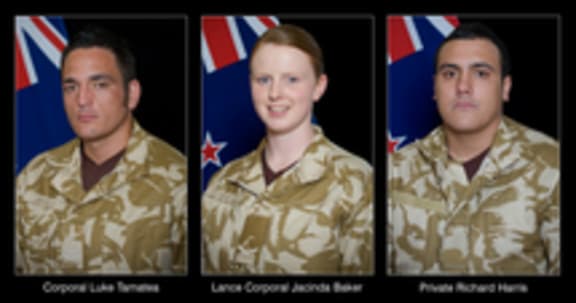Prime Minister John Key says New Zealand forces did not direct the airstrike that killed a Taliban commander held responsible for four New Zealand soldier deaths in Afghanistan.
Mr Key says the SAS was involved in the intelligence gathering, but not the military action itself.
The Defence Force says Abdullah Kalta was killed in a coalition air strike at Karimak village in Kahmard district, in the northeast of Bamyan province, on 21 November. Four other insurgents also died.
Kalta, a Taliban leader in a district of Baghlan province, was held responsible for the deaths of four New Zealand soldiers in two attacks in Bamyan province this year and in 2010. The Defence Force says he planned and led the attacks.
Lance-Corporal Jacinda Baker, Corporal Luke Tamatea and Private Richard Harris died in a roadside bombing in August 2012.
Lieutenant Tim O'Donnell died in an attack on a New Zealand patrol in August 2010.

The three soldiers killed in Afghanistan in August. Photo: DEFENCE FORCE
Mr Key says five or six SAS members in Afghanistan have been providing planning and logistical support to the United States or British special forces.
"They've gathered information, that information has been passed on to ISAF (the International Security Assistance Force and ISAF have undertaken an operation which has seen these five insurgents killed.
"So essentially New Zealand builds the picture of where these people are; it builds the case that leads to the legal support but the actual operations and the commanding of those operations are carried out by ISAF."
Mr Key says troops in Bamyan province, where New Zealand has a provincial reconstruction team, will be safer now that Kalta has been killed.
He says he hasn't been advised there were any civilian casualties in the attack.
A military security consultant, Paul Buchanan, said earlier on Monday it was very likely that support involved SAS personnel directing the airstrike from the ground from as near to the target as a few hundred metres.
He says an airstrike on a militant requires eyes on the ground to confirm the person being targeted.
"You don't want to have civilians in the way when that airplane comes over the hill and so I reckon that the SAS in particular would have been in close proximity when that missile hit."
Mr Buchanan says the SAS could have carried out the strike on Kalta itself, but New Zealand chose for diplomatic and domestic political reasons to get someone else to fire the shot.

